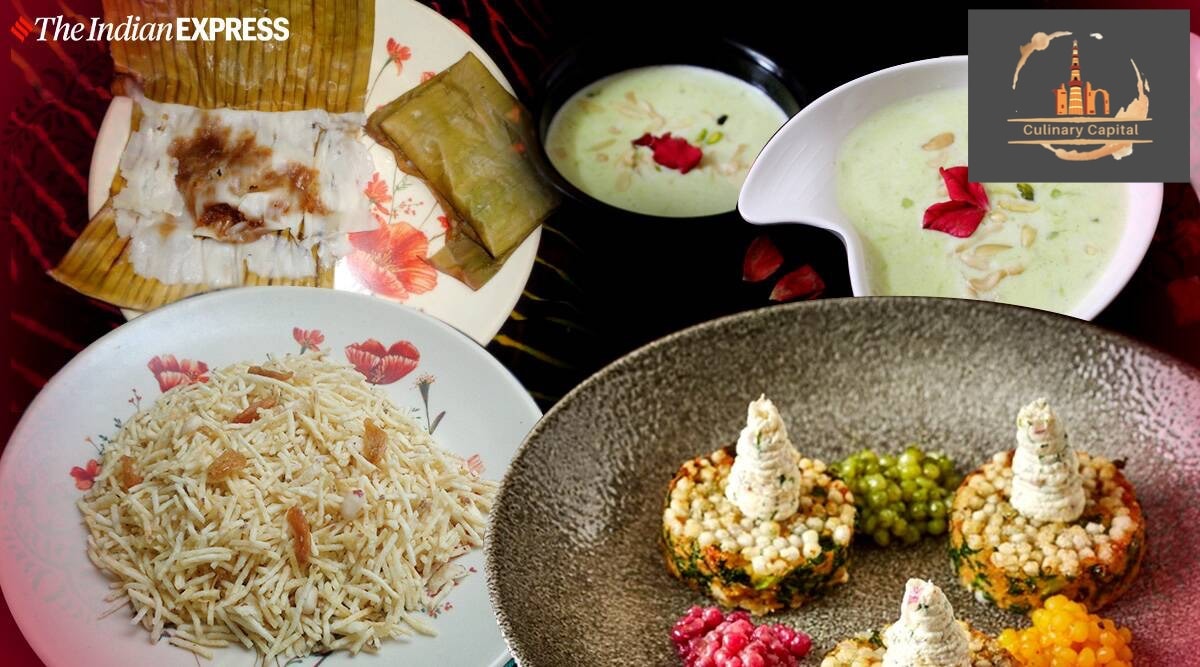 Generally, a Navratri thali features legumes, millets, mostly root vegetables like potato or tapioca, raw banana, wood apple or pumpkin chutney and papad. (File photo)
Generally, a Navratri thali features legumes, millets, mostly root vegetables like potato or tapioca, raw banana, wood apple or pumpkin chutney and papad. (File photo)We may be going gaga over intermittent fasting without realising that our living traditions like Navratri had already legitimised it through a nine-day period of once-a-day meal, meditation and sleep. While the nine days are meant to celebrate Shakti or the sacred feminine, the food regime has civilisational roots before religion. In fact, the Navratri thali emerged from our ancient fertility rituals and crop cycles.
The garba, or a celebration of the garbha (womb) of Mother Earth, is a tribute to the eternal cycle of creation. As food anthropologist Madhulika Dash says, “Fertility has been the core foundation of Navratri. Chaitra and Sharad are the two harvest seasons. Sharad takes us to winter. So, in our ancient societal timeline, there was not much work outdoors and householders focussed on family life. Most weddings still happen in winter.”
The other more practical reason for the set menu of nine days was to finish the summer bounty and preserve fruits and vegetables for the winter, particularly in the hills. Also, the platter was meant to prime our bodies for the cold season. Explaining the diet logic, Dash says, “The singhara (water chestnut) and koottu (buckwheat) ka atta (flour) clean, repair our liver and gallbladder and prepare them for the heat-producing food in winter. They are rich in fibres, complex carbohydrates and are gluten-free. They control blood sugar, are energy-giving and keep you full for a long time. Besides, they are rich in essential minerals. Both gluten and dairy take a long time to be broken down and digested, which is why their use is minimal.
“We use sendha namak or rock salt that helps take care of our sodium and potassium levels and rids the body of water retention. It controls your blood pressure and helps absorb minerals better than common salt. Buttermilk is rich in probiotics and good for gut health. All of this calms and soothes your body processes, giving you a zen feeling.” In fact, a balanced platter energises us so much that dandiya becomes a joyous adrenaline-pumping affair.
The ‘one large meal’ formula automatically translates into intermittent fasting as the food gap increases by 12 to 14 hours. The first sugar burst comes from fruits, which take time to be digested. So, by the time you get to your thali, you cannot overeat. And since you are not allowed to sleep for two hours after your big thali (ritualised as your meditative hours), the food doesn’t sit heavy on your stomach. Instead, it calms your brain and you slip into a deep sleep, healing your body in the process.
Much of the thali’s components are dependent on local produce. So, while the platter is heavy on legumes in the north, down south there is a lot of tapioca and tamarind, which help in energy distribution. Millets and roots feature abundantly as does sabudana or sago, a complex carbohydrate or resistant starch, which gives energy, regulates blood pressure and improves the nervous system.
The food logic is fairly simple. “There are no spices, just a tempering of jeera (cumin), dhania (coriander) or hing (asafoetida) to aid digestion. The food is layered in such a manner that it looks rich. And because it is cooked in ghee (not deep fried but usually dribbled from the top), it builds satiety. Pickles are not allowed, so for zest and finish you can have chutneys. Down south they have the pachadi, made of neem flowers, raw mango, jaggery, pepper powder and coconut shavings. This increases your saliva and helps you masticate your food better. No cravings happen thereafter,” says Dash.
So what does a common thali look like across the country?
Generally, it features legumes, millets, mostly root vegetables like potato or tapioca, raw banana, wood apple or pumpkin chutney and papad. There is also a hint of warrior food in the platters of Kashmir and east India where meat is used. “Traditionally, the meat, with just a dash of cumin, elephant foot or yam, papaya, ginger and pepper, is featured on platters in Kashmir for the first six days. The idea was to spare vegetables, sun dry and preserve them for the snow-bound months. In eastern India, fish and meat make an appearance on the ninth and tenth days,” says Dash.
Most accounts of food historians attribute the current thali to the 18th and 19th centuries. Today’s restaurants have taken it further. The Taj Hotels have had a consistent loyalty over the years with their Navratri thali, according to executive chef Rishikesh Rai of Taj Vivanta, Dwarka. “We make a grilled patty with raw banana and fig, potato and water chestnut curry, arbi curry, kuttu ke roti, pumpkin and potatoes, raita, pudina chutney and saboo dana kheer. Dishes are prepared with peanut oil or ghee,” adds Rai.
Should you choose Sattvik at Saket District Centre, don’t miss out on raw banana dahi bhalle or the chikoo malai rabri. You would never consider Gulati on New Delhi’s Pandara Road, a meat lover’s haven, to get original on a Navratri platter. But it has one of the best thali options in the city, its sabudana tikkis standing out as much for their flavour profile as for their fullness. Try out the buckwheat dumplings, amrood ki sabzi and the gulab ki kheer at AnnaMaya in Aerocity. And while Haldiram’s may seem avoidable, it would be a good idea to end your sampling with its makhane ke kheer. Who knew food science could be a multiverse of flavours?